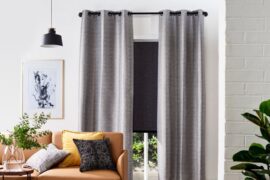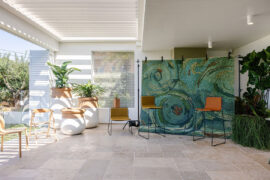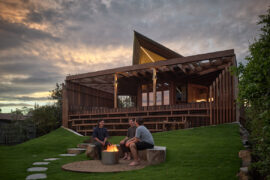Indesign Deputy Editor Penny Craswell chats with studio one8one7’s Marcus Piper and Christey Johansson about the new look Indesign magazine. Also, get a sneak peak of a few spreads below before you grab your own copy.
May 27th, 2009
One8one7 is a studio based on the idea of collaboration, an idea developed through 10 years of magazine design and seeing the results collaboration can bring to a project.
Launched in July 2008, award-winning studio one8one7 is based on the NSW South Coast and is a partnership between Marcus Piper and Christey Johansson.
Studio one8one7 are the creative force behind Indesign magazine’s new visual identity.
What were your key principles in approaching the re-design of Indesign?
The key principals in the re-design where to keep it simple, and to create an exclusive identity for the magazine which had an underlying function. We are editorial designers and our approach was to tell stories and deliver information – not to over-ride or complicate the publication with design tricks.
What publications in graphic design history inspired you?
Strangely, the functionality of magazines like TIME, newspapers like the Guardian, the re-design of Creative Review and the editorial approach of Simon Esterson. We try to ignore design magazines in a process like this as you are led down the same paths. We gain inspiration from thought and function – not so much aesthetics.
Tell us about the new fonts in the magazine – Indesign and National.
We were very excited to include new weights of the National family for this project, a typeface design by Kris Sowersby (SP) from New Zealand. Kris is a world class typographer and thus it seemed appropriate to include his work in the leading creative magazine for the region.
To give the magazine it’s exclusive identity one8one7 developed a bespoke ’hero’ font for the mag – named indesign. Inspiration came obviously from the typographic work of Wim Crouwel but more so from the geometric structural forms and details found in the architecture of Herzog deMueron and Konstantin Grcic. Forms which are perhaps uncomfortable from a first glimpse but have an underlying functionality and level of intrigue.
These references were incorporated with traditional typographic concepts and the proportions of the new indesign page to give a monospaced typeface with a touch of personality though detail.
What about the cover tip-on – what gave you the idea and why is it so great?
The tip-on and cover is the perfect ’want your cake and eat it too’ scenario: The idea developed from the way newspapers sell them selves on the news stand, which is a direct contrast to the way design magazines deal with engaging a potential buyer. The old argument of cover lines v beautiful imagery.
Combining these two directions in a flat cover results in a magazine which is unattractive once owned. Not something you want screaming at you from your coffee table or foyer everytime you see it. The end results provides the best of both world’s, informing the audience of the content and providing a beautiful object once owned. If it were laundry detergent they’d call it packaging.
How did you allow for easy navigation in the magazine?
Our first task was to break the magazine down into it’s elements and examine how it worked as an entire magazine. Our first step in the navigation was to give the magazine an identity of it’s own. Composition and typographic hierarchy. From there we looked at the sections, giving each one an identity of it’s own within the look and feel of the magazine. The main features, being Portfolio, is broken down into categories through a simple colour tabbing, referenced on the content page.
Essentially, we want the reader to know when they look at an editorial page and to know they are in INDESIGN magazine. We introduced a play on the name of the magazine also, LUMINARY INDESIGN and so on as an additional magazine specific device. It a unique position to have a word, like INDESIGN, and a wonderful play on words can be used.
What is the balance between content and graphics in the magazine?
The balance between content and graphics is based on composition and story telling. It is an editorial approach, where graphic devices are stripped back, and functionality and letting images and text do the communicating is used.
The design style simply allows the content to speak to the reader but gives the magazine a thoughtful and structured platform to showcase the content.
INDESIGN is on instagram
Follow @indesignlive
A searchable and comprehensive guide for specifying leading products and their suppliers
Keep up to date with the latest and greatest from our industry BFF's!

Rising above the new Sydney Metro Gadigal Station on Pitt Street, Investa’s Parkline Place is redefining the office property aesthetic.

Merging two hotel identities in one landmark development, Hotel Indigo and Holiday Inn Little Collins capture the spirit of Melbourne through Buchan’s narrative-driven design – elevated by GROHE’s signature craftsmanship.

Join us as we cycle around the world’s ‘Most Liveable’ city with Richard Weinman of Warren and Mahoney and Herman Miller X Rapha!
Project: Australian Bureau of Statistics Office Project Overview:When surrounded by a sea of highrise it is nice to have a small piece of nature at your feet. The design team at Tsar worked with Heidi McIlveen of CCPCORP to create a unique flooring solution for the Australian Bureau of Statistics office in Market St, Sydney […]
The internet never sleeps! Here's the stuff you might have missed

Rising above the new Sydney Metro Gadigal Station on Pitt Street, Investa’s Parkline Place is redefining the office property aesthetic.

A lighter, roomier feel in your space can start at your window.

Tappeti’s latest rugs have been unveiled at one of Luigi Rosselli’s stunning Sydney coastal homes alongside furniture by Design Nation.

Recognised as a winner at the INDE.Awards 2025, Barton Taylor has received The Photographer – Residential accolade. His photographic work on Cake House captures the soul of a coastal icon reimagined, blending light, texture and atmosphere into a compelling visual narrative.